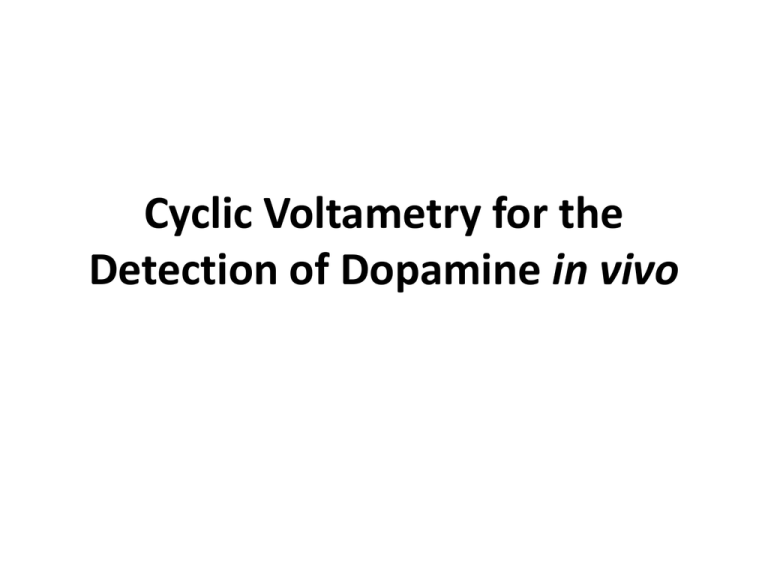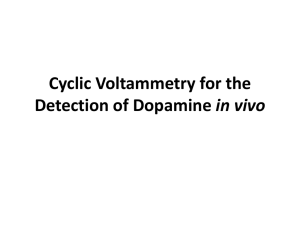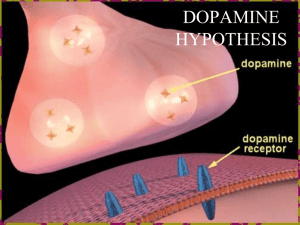Cyclic Voltammetry and the Detection of Neurotransmitters
advertisement

Cyclic Voltametry for the Detection of Dopamine in vivo Dopamine • Neurotransmitter – small molecule chemical messenger • Important for motor and cognitive functions – Deficts in dopamine levels cause Parkinson Disease • Regulates reward – Dopamine increases after drugs of abuse like cocaine Structure of Dopamine. 4-(2-aminoethyl) benzene-1,2-diol Dopaminergic Neurons • Dopamine is synthesized in dopaminergic neurons and packaged into membrane bound vesicles • Electrical action potential initiates the release of dopamine • Dopamine vesicles undergo exocytosis – Spills out into the extracellular space – Can be detected The dompaminergic neuron can release dopamine into the extracellular space where its contents can be detected by target neurons. Detection of Dopamine • Exocytosis of dopamine from vesicle occurs on a millisecond time scale • Sensor must be fast, sensitive, and selective since dopamine concentrations are low • Fast scan cyclic voltametry is the dominant electrochemical technique used Dopamine HO HO N H2 Dopamine-o-quinone - 2e - O N H2 + 2 H+ O Carbon Fiber Microelectrodes • Carbon Fiber Microelectrodes (CFME) are electrodes in which a carbon fibers serve as the electroactive area • Advantages: – Carbon fibers are biological compatible to cells – Small size (less than 10um in diameters) allows for implantation in vivo • Commonly used with cyclic voltametry Carbon Fiber Microelectrode Voltammetry • Electrochemical technique in which the current (I) is measured as a function of voltage (Eapp). • There are several kinds: – Linear Scan voltametry (Polarography) – Differential pulse polarography – Square-wave voltametry – Cyclic Voltametry Fast-scan Cyclic Voltametry 1.3 V 400 V/s -0.4 V 100 ms 8.5 ms Scan electrode from a holding potential to a switching potential and back at a high scan rate. Repeat these scans every 100 ms. Dopamine HO HO Dopamine-o-quinone N H2 - 2e - O N H2 + 2 H+ O As potential is ramped up, dopamine is oxidized to dopamine-o-quinone. As potential is ramped down, dopamine-o-quinone reduced back to dopamine. Fast-Scan Cyclic Voltametry Cyclic voltammograms No dopamine Dopamine present Background-subtracted cyclic voltammogram of dopamine oxidation reduction Fast scan rate cause a large background charging current due to charging the double layer. The background current is stable and can be subtracted out to obtain a backgroundsubtracted cyclic voltammogram for dopamine. When dopamine is added (red line), the differences are small. The position of the peaks help identify the molecule being detected. Fast-scan cyclic voltametry E EvsvsAg/AgCl Ag/AgCl -0.4VV -0.4 10ss 10 dopamine reduction 33 00 1.0VV 1.0 i, nA dopamine oxidation -0.4VV -0.4 -5 -5 i, nA dopamine present •Data can also be depicted as a color plot to show many CVs over time. •Current is in color and shows when dopamine is present. Results Electrically-Stimulated release in a rat •Carbon-fiber microelectrode implanted in nucleus accumbens •Nucleus accumbens regulates reward •Electrically stimulate cell bodies in ventral tegmental area •Size of dopamine evoked depends on frequency of stimulation • Color plots look like dopamine Results Spontaneous dopamine transients in a rat Spontaneous dopamine transients in a rat after cocaine •Cocaine increases the concentration and the length of time for dopamine signaling. Advantages • Allows real-time detection of dopamine in behaving animals • Can determine during what behaviors dopamine is released • Can determine how drugs affect dopamine signaling in the brain









